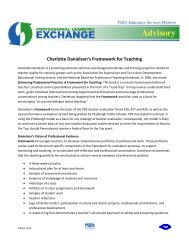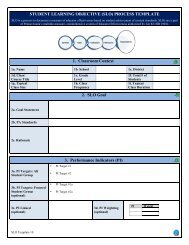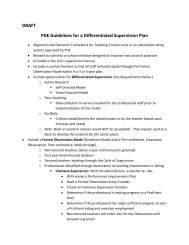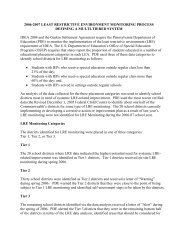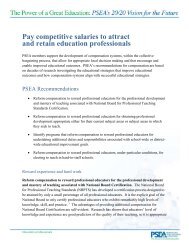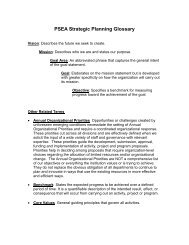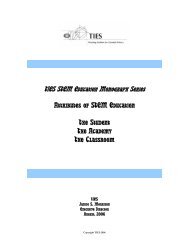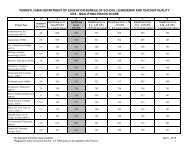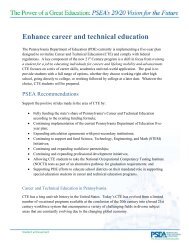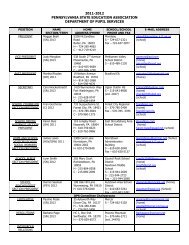Student PSEA Outreach to Teach: Secondary Lesson Plan
Student PSEA Outreach to Teach: Secondary Lesson Plan
Student PSEA Outreach to Teach: Secondary Lesson Plan
You also want an ePaper? Increase the reach of your titles
YUMPU automatically turns print PDFs into web optimized ePapers that Google loves.
<strong>Student</strong> <strong>PSEA</strong> <strong>Outreach</strong> <strong>to</strong> <strong>Teach</strong>: <strong>Secondary</strong> <strong>Lesson</strong> <strong>Plan</strong><br />
Park Forest Middle School ‐ April 3, 2009<br />
Unit of Study: Environment<br />
Topic: How ecologically friendly are you?<br />
Prior Knowledge:<br />
‐General background knowledge of environmental issues<br />
‐Understand the basic concepts of recycling<br />
‐Basic math skills (multiplication tables)<br />
Essential Questions:<br />
What are current environmental issues?<br />
What impact do your actions have on the environment both <strong>to</strong>day and in the future?<br />
Objectives: <strong>Student</strong>s will be able <strong>to</strong>:<br />
‐evaluate daily actions by answering a survey on their choices and how those choices impact the<br />
environment<br />
‐work in groups <strong>to</strong> calculate how much waste they generate per week, how much waste their family<br />
generates per week and how much waste the student body generates in a year.<br />
‐ work in groups <strong>to</strong> make a list with ideas on how <strong>to</strong> reduce the waste that students at Park Forest<br />
Middle School generate at school and at home<br />
‐share unique ideas <strong>to</strong> reduce waste with the class<br />
Materials Needed:<br />
‐ Environmental Impact Quiz<br />
‐ Calcula<strong>to</strong>rs<br />
‐ Lined pieces of paper<br />
‐ Pencil or pen
Game <strong>Plan</strong>:<br />
Activating Strategy:<br />
Give students environmental impact quiz. Give students about 3 minutes <strong>to</strong> complete the quiz and<br />
compute their final score.<br />
1. Environmental Impact Quiz<br />
7 minutes <strong>to</strong>tal (<strong>to</strong> pass out quizzes, complete quizzes and share scores)<br />
<strong>Teach</strong>ers Actions<br />
<strong>Teach</strong>ers pass out quizzes, one <strong>to</strong> every student.<br />
<strong>Teach</strong>er asks students <strong>to</strong> share their scores with<br />
the class (choose a few students <strong>to</strong> be examples).<br />
<strong>Student</strong>s Actions<br />
<strong>Student</strong>s take quiz individually. <strong>Student</strong>s calculate<br />
scores and share scores.<br />
Step‐by‐Step:<br />
*<strong>Teach</strong>er asks students <strong>to</strong> assemble in<strong>to</strong> small groups (3‐4 small groups depending on the class)*<br />
Each <strong>Student</strong> <strong>PSEA</strong> member takes a group and teaches their small group this lesson<br />
2. Direct <strong>Teach</strong>ing : Calcula<strong>to</strong>rs and lined piece of paper need for this section<br />
8 minutes<br />
<strong>Teach</strong>er Actions<br />
<strong>Teach</strong>er presents <strong>to</strong> the class that nearly 5 pounds<br />
of waste is generated per person per day. How<br />
much waste would you generate in a week?<br />
<strong>Teach</strong>er instructs students <strong>to</strong> think about how<br />
much waste their family generates per week.<br />
<strong>Teach</strong>er instructs students <strong>to</strong> think about and<br />
calculate how much waste their student body (763<br />
students) generates in a year. <strong>Student</strong>s should<br />
take 763 (student body) and multiply it by 5<br />
(pounds of waste generated per day) and then by<br />
365 (number of days in the year).<br />
<strong>Student</strong> Actions<br />
<strong>Student</strong>s bring calcula<strong>to</strong>rs <strong>to</strong> groups and multiply 7<br />
by 5 <strong>to</strong> figure out that 35 pounds of waste is<br />
generated per person per week.<br />
<strong>Student</strong>s multiplies 35 times the number of people<br />
in their family. <strong>Student</strong>s share answers with their<br />
group. (<strong>Student</strong>s use lined paper and calcula<strong>to</strong>rs<br />
as needed).<br />
<strong>Student</strong>s generate number of how much waste<br />
their student body generates in a year. They will<br />
get how many pounds of waste is generated per<br />
year by their student body. 1,392,475 pounds
3. Checks for Understanding: Lists of ideas <strong>to</strong> reduce waste (Notebook paper and pencil needed for this<br />
section)<br />
10 minutes<br />
*In groups*<br />
<strong>Teach</strong>er Actions<br />
<strong>Teach</strong>er instructs students <strong>to</strong> brains<strong>to</strong>rm as many<br />
ways as possible <strong>to</strong> reduce the waste that the<br />
student body generates both at school AND at<br />
home.<br />
<strong>Teach</strong>er helps their small group <strong>to</strong> think of ideas.<br />
<strong>Student</strong> Actions<br />
<strong>Student</strong>s think of ideas such as Buying less, buying<br />
less packaging, reusing, recycling, composting, etc,<br />
share these ideas as a group. <strong>Student</strong>s should be<br />
thinking of as many ideas <strong>to</strong> reduce waste and<br />
help the environment as possible.<br />
<strong>Student</strong>s share original ideas and then make a list<br />
of ideas <strong>to</strong> reduce waste. <strong>Student</strong>s can write their<br />
ideas down on a piece of note book paper.<br />
<strong>Student</strong>s have 10 minutes <strong>to</strong> make this list.<br />
3. Sharing Time/Closure: <strong>Student</strong>s share list of ideas on how <strong>to</strong> reduce waste with the class<br />
10 minutes<br />
<strong>Teach</strong>er Actions<br />
<strong>Teach</strong>ers supervise their group when they are<br />
sharing. <strong>Teach</strong>ers then ask the students who has<br />
the most ideas that were not used by other<br />
groups. This group is then the winner!<br />
<strong>Student</strong> Actions<br />
<strong>Student</strong>s share their lists with the class. As the<br />
groups are presenting all students should be<br />
listening <strong>to</strong> find ideas that are the same as theirs.<br />
If another group has the same idea as the idea<br />
currently being shared, the group members will<br />
raise their hand and each group will scratch that<br />
idea off of their list. All groups will share and the<br />
other groups will continue <strong>to</strong> raise their hands if<br />
their list also contains that idea. The group with<br />
the most amount of ideas that were not thought<br />
of by other groups will be the winners.



